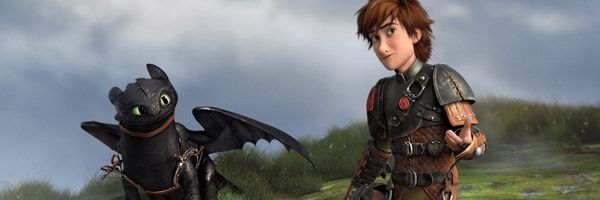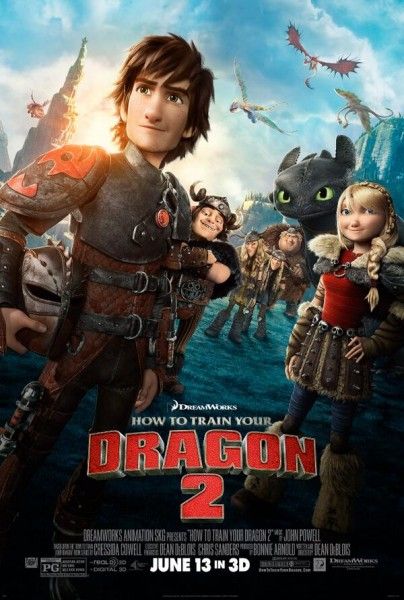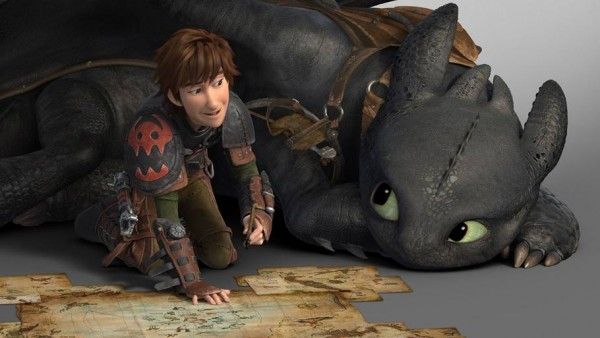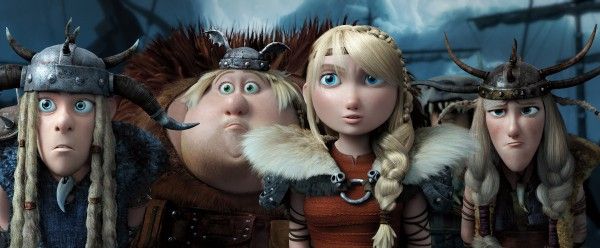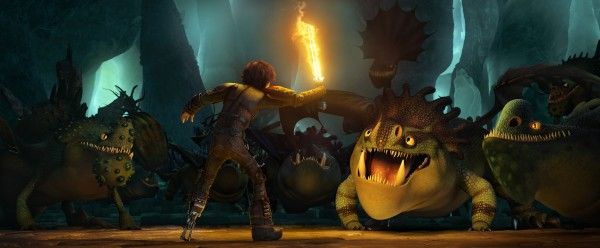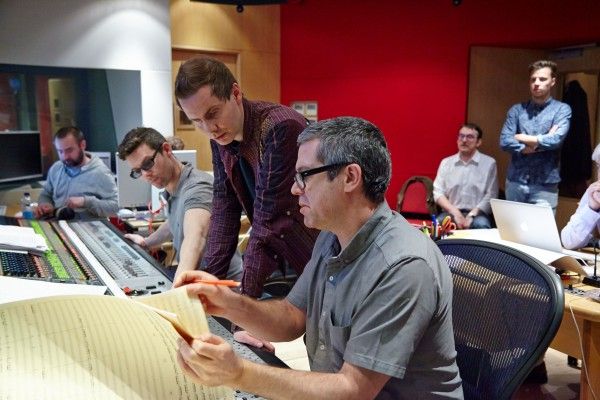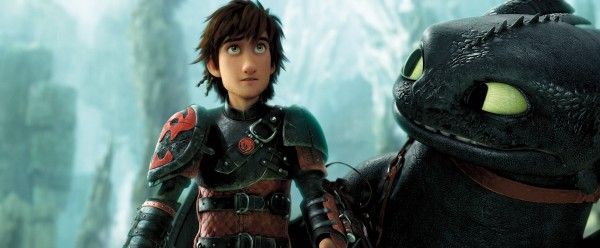Arriving in theaters this Friday is How to Train Your Dragon 2, the highly anticipated follow up to 2010's surprise critical and commercial success How to Train Your Dragon, which won over audiences and critics alike with its immersive world, lovable cast of characters, and emotional heft. The sequel picks up five years later on the island of Berk where dragons and Vikings have learned to thrive harmoniously together after decades of mutual destruction. But when a menacing dragon trapper threatens their newfound way of life, Hiccup and Toothless set off on another adventure, facing bigger and broader challenges with the threat of greater consequences. Returning cast members Jay Baruchel, Gerard Butler, America Ferrera, Craig Ferguson, Christopher Mintz-Plasse, Kristen Wiig, T.J. Miller and Jonah Hill are joined by newcomers Cate Blanchett, Djimon Hounsou and Kit Harington.
I recently had the opportunity to visit the DreamWorks Animation studio in Glendale, California with a number of other journalists where we caught an advanced screening of the film, participated in a Q&A with director Dean DeBlois, and got an inside look at the behind-the-scenes process of creating an animated film. Hit the jump to check out my thoughts on the How to Train Your Dragon 2 and a bullet point summary of what I learned from the visit.
How to Train Your Dragon 2 is the best kind of sequel. It embraces and expands upon the themes of the first, respecting the material that preceded it, and continuing established character arcs without simply rehashing the events of the first film. It stands on its own as a story about the joys and terrors of facing adulthood. By picking the story up five years later, DeBlois allows his characters to mature, and likewise matures the film alongside them.
The stakes are even higher this time around as Hiccup faces bigger challenges, tougher decisions, and confronts the sometimes tragic rites of passage we must all face as we step into our own maturity. Perhaps most wonderful is the way the film continues to inspire virtue in its audience, Hiccup's consistent faith in others a refreshing rebuttal to our age of jaded cynicism.
Technically, the film looks absolutely incredible. Utilizing a new animation software called Apollo, DreamWorks animators have crafted a visually stunning film. The flying sequences are just as thrilling and eye-popping as the first time around, but everything looks just a little bit better and sharper, more elegant and refined. The production design is breathtaking; costumes, environments, and of course, dragons, all crafted with stunning attention to detail. It is, dare I say, some of the finest world building since Harry Potter. And the 3D only enhances the experience. I'm pretty picky about the films I see in 3D, but this one is absolutely worth the cost of admission. The strength of the animation also lends veracity to the film's tender and dramatic beats. These emotional moments resonate more clearly as each characters' face and range of expression is rendered with delicate care and attention to detail. And of course, it must be mentioned that the score is on point. Composer John Powell succeeds at reinventing his beloved score from the first film, matching its potency without relying too heavily on what he did before. All told, How to Train Your Dragon 2 could just as easy be titled How to Make a Great Sequel. It's a truly fantastic film, and perhaps the movie to beat this summer.
Following the screening we had a brief Q&A with director Dean DeBlois. The highlights are below (Please be aware there are some slight spoilers):
- How to Train Your Dragon 2 is the first film created using a new animation software called Apollo.
- Apollo was designed to be a combination of all the best qualities from varying animation techniques: the immediacy of hand-drawn in animation, the tangibility of stop-motion, and the infinite editing possibilities of computer animation. The software puts the pen back in the artist's hands, giving them the power to control and manipulate the image in front of them with immediacy. It's a much more intuitive form of animation.
- For How to Train Your Dragon 2, the Apollo software allowed for exceptional subtlety, detail, and nuance in the performances. Most notably in emotional scenes like Stoick's reunion with his long-lost wife Valka.
- It also allowed for highly populated and complex action sequences such as the attack on Dragon Mountain teased in the trailers. With Apollo they were able to create thousands of men, dragons and machines, increasing the scope and scale of the action.
- The sequel was greenlit a month after the first film's release. It took them the full four years to finish the second film, starting almost immediately after the premiere of the first and finalizing this film only a matter of weeks ago.
-
DeBlois' counter-pitch to executives was rather than make an aimless sequel, the series should become a trilogy with the first film serving as the first act, the sequel as the second act, and the third as a conclusion to complete the story. This trilogy will chronicle Hiccup's full coming of age, beginning with him as a small boy and ending with him as the wise Viking chief.
- How to Train Your Dragon 2 was written to mature with the characters. Hiccup has a very different journey from the first film. In How to Train Your Dragon Hiccup's main desire was to win his father's approval, gain acceptance among his peers, and get the girl. As DeBlois says, "He got all those things and a cool dragon. What's the problem?" There needed to be a reason for the sequel. By meeting Hiccup again as a 20-year-old he's in a different stage of life, on the threshold between youth and adulthood, ready to embark on a new journey of discovery.
- The first film was originally intended to be a direct adaptation of Cressida Cowell's books, but the story was a little too small and too young. DeBlois and Chris Sanders (who co-wrote and co-directed the first film) were tasked with reinventing the story to make it a bigger, more action-oriented film. Naturally, with the second film taking place five years after the first, and introducing more mature themes, it diverges even more significantly from the source material.
- DeBlois singled out The Empire Strikes Back as the best sequel of all time, citing it as an inspiration and guidepost to making a great sequel. He also admired that it appealed to such a broad audience, saying it's his goal to make a four-quadrant film and not just a kids movie.
-
Count on learning about some new Dragon species. The writers love exploring the variations of traits and personalities that exist throughout the different species. They design them for the purposes of the characters introduced in the film.
- You can also look forward to learning more about the hierarchy of dragons hinted at in the first film. Remember the queen-bee type dragon that all the other dragons served and feared? This time around we get a look at the next level up the food-chain, the Alpha Dragon - a king of the dragons capable of forcing its will upon others through ultra-sensory communication.
- The finalized film is a product of collaboration between 30 and 40 animators. However, they often borrow animators in the last few months to finish the film on time and that number can goes high as 50.
- DreamWorks is equipped with a motion capture studio. While the final film was not made using motion capture, this resource is often used during the pre-vis stage of animation.
- Production designer Pierre-Olivier Vincent (affectionately known as POV) took us through the creative process of designing Hiccup and aging him up for the second film. He showed us at least fifty different iterations of Hiccup, some too young looking, some too goofy, some too severe. It was an immense process of trial and error to decide on the final look. While Hiccup was not directly designed after Jay Baruchel, the animators did incorporate elements of his movement and body-mechanics.
-
On John Powell's beloved score, DeBlois believes Powell "outdid himself", finding a way to reprise some of the themes, expand upon them, and use them in exciting new ways, as well as introducing beautiful new themes.
- One of these new themes is "Lost and Found", a musical representation of one of the film's central narrative motifs. Every character is losing or finding something, someone, or some part of themselves.
- DeBlois wrote the part of Valka specifically for Cate Blanchett. He describes Valka as a Jane Goodall type character who's been cut off from humanity. She needed to be vulnerable and emotional in certain scenes, but also capable of being authoritative and commanding. Blanchett was the first to come to mind due to the broad range she demonstrated in films like Elizabeth.
- He first approached Blanchett at the 2011 Academy Awards, telling he was writing a part for her and the second film. She expressed interest because her kids liked the first film so much. DeBlois said there at the awards, in her stunning gown and gorgeous hair, she began adopting the mannerisms of a woman living in the wild, already bringing her own interpretation to the character.
- Replying to one journalist's comment that the film is too emotionally intense for their three year old, DeBlois stated, "There's probably an appropriate age for the movie and three is a little young." In this writer's humble opinion, many of the greatest animated "kids" films include moments of intense emotional catharsis. How to Train Your Dragon 2 certainly earns its PG rating, but it's nothing children of an appropriate age can't handle.

